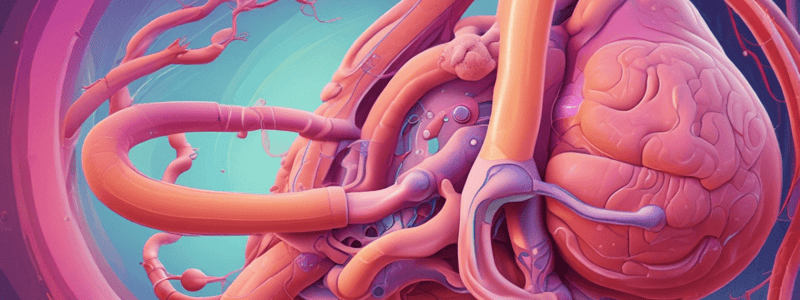Podcast
Questions and Answers
Which structure releases renin to trigger the Renin-Angiotensin-Aldosterone System (RAAS)?
Which structure releases renin to trigger the Renin-Angiotensin-Aldosterone System (RAAS)?
- Nephron loop
- Macula densa cells
- DCT
- Juxtaglomerular cells (correct)
What is the role of ANH in the regulation of water and sodium in the DCT and Collecting duct?
What is the role of ANH in the regulation of water and sodium in the DCT and Collecting duct?
- Stimulates potassium excretion
- Inhibits sodium reabsorption (correct)
- Increases sodium retention
- Promotes water reabsorption
Which process creates the medullary osmotic gradient in the kidney?
Which process creates the medullary osmotic gradient in the kidney?
- Countercurrent multiplier (correct)
- Renal Clearance
- Filtration
- Tubular Reabsorption
What is the primary function of Tubular Secretion in the nephron?
What is the primary function of Tubular Secretion in the nephron?
What impacts Glomerular Filtration Rate (GFR) in the kidneys?
What impacts Glomerular Filtration Rate (GFR) in the kidneys?
Which mechanism is responsible for maintaining a stable Glomerular Filtration Rate (GFR) despite changes in systemic blood pressure?
Which mechanism is responsible for maintaining a stable Glomerular Filtration Rate (GFR) despite changes in systemic blood pressure?
Study Notes
Glomerular Filtration
- The process of filtering substances from the blood into the nephron occurs through a filtration membrane in the renal corpuscle
- Substances filtered: water, ions, urea, glucose, amino acids, and water-soluble vitamins
- Substances not filtered: large proteins and blood cells
- Pressure gradients: GHP (glomerular hydrostatic pressure), CCOP (capsular colloidal osmotic pressure), CHP (hydrostatic pressure in Bowman's capsule), and GCOP (colloidal osmotic pressure in glomerular capillaries)
- Effective Filtration Pressure (EFP) determines the Glomerular Filtration Rate (GFR)
Regulation of Glomerular Filtration Rate (GFR)
- Two autoregulatory mechanisms:
- Myogenic mechanism: adjusts afferent arteriole diameter to maintain constant blood pressure
- Tubuloglomerular feedback: macula densa cells sense tubular fluid composition and adjust GFR accordingly
- Juxtaglomerular cells release renin, which triggers the Renin-Angiotensin-Aldosterone System (RAAS)
Tubular Reabsorption and Secretion
- Proximal convoluted tubule (PCT):
- Reabsorbs water, ions, urea, glucose, amino acids, and water-soluble vitamins
- Secretes drugs and H+
- Nephron loop:
- Descending limb: reabsorbs water and ions
- Ascending limb: reabsorbs ions and secretes urea
- Distal convoluted tubule (DCT) and Collecting duct:
- Reabsorbs water, sodium, and bicarbonate
- Regulated by ADH, aldosterone, and ANH
- Secretes H+, K+, and ammonium ions
Urine Concentration and Renal Clearance
- Countercurrent multiplier: creates a medullary osmotic gradient to concentrate urine
- Recycling of urea: creates a medullary osmotic gradient to concentrate urine
- Countercurrent exchanger: maintains the medullary osmotic gradient
- Renal clearance: measures the efficiency of the kidneys in removing substances from the blood
Micturition and Urine Composition
- Micturition reflex: controlled by the external and internal urethral sphincters
- Urine composition: influenced by kidney function, diet, and overall health
Studying That Suits You
Use AI to generate personalized quizzes and flashcards to suit your learning preferences.
Description
Test your knowledge on concepts related to glomerular filtration, renal corpuscle, pressure gradients, Glomerular Filtration Rate (GFR), autoregulatory mechanisms, tubular reabsorption, and more in renal physiology.




